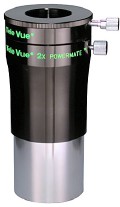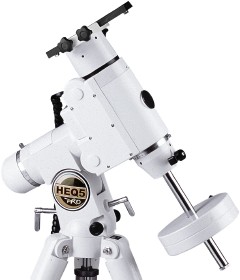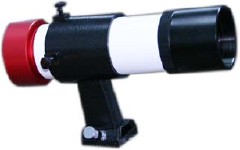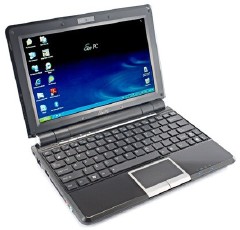Gearing up for astrophotography
All the positive feedback I’ve received for my recent attempts at lunar photography have made me more enthusiastic than ever about getting into astrophotography. I’ve already got a few books on the subject; truth be told, there’s a bit of a learning curve. It’s going to take me a while to get good at this. And that’s not a bad thing, because astrophotography can be awfully expensive: it’s going to take me a while to assemble all the equipment required for a basic astrophotography rig that can do more than just photograph the Moon.
I’ve already got two main pieces of equipment. I have a telescope geared towards astrophotographers: an 80mm Sky-Watcher Equinox apochromatic refractor, with really good colour correction (as far as I can tell) and a short (500mm, f/6.25) focal length. I also have a digital SLR sufficient to the task: a Nikon D90. (Most astrophotographers use Canon, whose noise reduction algorithms are better for stars, but a Nikon is hardly unacceptable.) In addition, I have a number of accessories for the D90 that will help: an external battery pack (to aid with multiple long exposures in the cold), a corded remote (to reduce camera shake when pressing the shutter), and a right-angle finder (to aid in focusing and allow me to see through the camera when it’s attached to a refractor or catadioptric telescope). I also have T-ring adapters to connect my camera to a telescope: one for a two-inch focuser (like my refractor), and one for Schmidt-Cassegrain telescopes.
So, what else do I need?
 The first piece of equipment I’m likely to get is a Televue Powermate. You may have heard of a Barlow lens, which increases the magnification of an eyepiece; Powermates add another doublet lens to this design to correct diverging light rays. Increasing the magnification of my refractor would really help my lunar photography. A 500mm refractor doesn’t magnify the Moon very much: it presents a very small image on my camera’s sensor. Doubling the focal length with a 2× Powermate would put the Moon on more pixels, making for a better image. (Alternatively, I could use my 125mm Schmidt-Cassegrain instead — it has a focal length of 1,250 mm — but it’s not as sharp and contrasty as an apochromatic refractor.) What clinches it for me is that Powermates have T-ring adapters (sold separately), which simplifies things: I can just stick the camera and T-ring into the Powermate, rather than sticking the camera and T-ring into a separate T-ring adapter that then slides into the Powermate. Total cost: A 2× Powermate for two-inch focusers lists for around $350-400 at Canadian stores; the T-ring adapter runs around US$50.
The first piece of equipment I’m likely to get is a Televue Powermate. You may have heard of a Barlow lens, which increases the magnification of an eyepiece; Powermates add another doublet lens to this design to correct diverging light rays. Increasing the magnification of my refractor would really help my lunar photography. A 500mm refractor doesn’t magnify the Moon very much: it presents a very small image on my camera’s sensor. Doubling the focal length with a 2× Powermate would put the Moon on more pixels, making for a better image. (Alternatively, I could use my 125mm Schmidt-Cassegrain instead — it has a focal length of 1,250 mm — but it’s not as sharp and contrasty as an apochromatic refractor.) What clinches it for me is that Powermates have T-ring adapters (sold separately), which simplifies things: I can just stick the camera and T-ring into the Powermate, rather than sticking the camera and T-ring into a separate T-ring adapter that then slides into the Powermate. Total cost: A 2× Powermate for two-inch focusers lists for around $350-400 at Canadian stores; the T-ring adapter runs around US$50.
 If I want to take pictures of anything other than the Moon or the planets, I’ll need an equatorial mount that will track the sky. The mount I’ve settled on is the HEQ5 Pro from Sky-Watcher, which Orion sells as the Sirius EQ-G
If I want to take pictures of anything other than the Moon or the planets, I’ll need an equatorial mount that will track the sky. The mount I’ve settled on is the HEQ5 Pro from Sky-Watcher, which Orion sells as the Sirius EQ-G. It costs around $1,200 and has a capacity of around 30 pounds (13-14 kg): more than enough for my three-kilogram refractor. But I’m thinking ahead a bit: this mount would also be able to handle Newtonian, Schmidt-Cassegrain and Ritchey-Chrétien telescopes with an aperture of eight inches (200mm) or less, or Maksutovs of six inches (150mm) or less — more than enough for a good long while. It’s also light enough — about 20 kilograms — to be reasonably portable, which is a factor when you don’t plan on setting up a permanent observatory any time soon. The HEQ5 Pro has a go-to computer and an autoguider port (more on which anon), as well as periodic (but not permanent) error correction (a way to train the computer to compensate for regular tracking errors in the gears; permanent PEC would have been better).
An autoguider corrects tracking errors brought on by imperfections in polar alignment and gears: it connects a small digital camera to the mount and a computer: when the camera catches a guide star moving in a way it shouldn’t, the computer pulses the mount’s motors to correct it. This is essential in long-exposure photography. How essential it will be for me is another question: an f/6.25 refractor is pretty wide-field (and presumably more forgiving of tracking errors), and a D90’s sensor will overheat if it runs for too long — and heat is a definite no-no for astrophotography (it adds noise). But if it turns out that five-minute exposures (for example) require autoguiding, then I think I’ve figured out which one to get.
The one generating the most buzz is Orion’s inexpensive $280 (U.S.) autoguider, which plugs into a computer for power and control and into the mount’s autoguider port. It also requires a separate guide scope (or, presumably, an off-axis guider
, which is less preferred nowadays), which would be problematic with my refractor, which has a built-in dovetail rather than using rings.
 On the other hand, KW Telescope in Kitchener, Ontario, has assembled an autoguider package that uses a 50mm finder scope and connects via the main telescope’s finder bracket — which my refractor has. Costs $350. I was worried that 50 mm would not be enough aperture to provide the camera with a guide star to lock onto, but Alan Dyer’s review in the March-April 2009 issue of SkyNews assuaged those fears. (You’re on the hook now, Alan.) This will not only save me from having to buy a guidescope-and-rings combination (Orion sells packages from $325 to $380), it will also take a few pounds off the mount’s, er, shoulders.
On the other hand, KW Telescope in Kitchener, Ontario, has assembled an autoguider package that uses a 50mm finder scope and connects via the main telescope’s finder bracket — which my refractor has. Costs $350. I was worried that 50 mm would not be enough aperture to provide the camera with a guide star to lock onto, but Alan Dyer’s review in the March-April 2009 issue of SkyNews assuaged those fears. (You’re on the hook now, Alan.) This will not only save me from having to buy a guidescope-and-rings combination (Orion sells packages from $325 to $380), it will also take a few pounds off the mount’s, er, shoulders.
Finally, if I’m getting an autoguider, I’m going to have to have a laptop computer to operate it — unless I opt for Orion’s new standalone autoguider, which doesn’t require a computer but which does require a power source, to say nothing of $600 (U.S.)! And, I hate to admit it, but that computer is going to have to run Windows (gakk!): all the autoguiders under discussion here use PHD Guiding for software, and while PHD Guiding is Mac-compatible, the drivers required to connect to these autoguiders aren’t. (Mac-compatible cameras are more expensive; what are you gonna do?) Besides, I’m not sure I’d want to subject a precious MacBook to the elements. My criteria for an astronomy laptop are that it (a) be inexpensive (so as not to cause grief if I break it) and (b) have crazy-stupid battery life.
 I just so happen to have a candidate in mind that appears to fit these criteria: the Asus Eee PC 1000HE, a Windows netbook with a 10-inch screen, a 1.6-GHz Atom processor, a 160-gigabyte hard drive — and a battery life claimed to be as high as nine and a half hours. (See posts about this computer at Engadget and Gizmodo.) Staples has it in stock, and sells it for $450. By the time I actually get around to buying one, however, it will almost certainly be supplanted by a newer model, but it’s good to know that what I’m looking for is more than theoretically possible.
I just so happen to have a candidate in mind that appears to fit these criteria: the Asus Eee PC 1000HE, a Windows netbook with a 10-inch screen, a 1.6-GHz Atom processor, a 160-gigabyte hard drive — and a battery life claimed to be as high as nine and a half hours. (See posts about this computer at Engadget and Gizmodo.) Staples has it in stock, and sells it for $450. By the time I actually get around to buying one, however, it will almost certainly be supplanted by a newer model, but it’s good to know that what I’m looking for is more than theoretically possible.
By this point, of course, I will have spent something like $2,600 including tax. This is a shopping list for the long term — in the next year or two, not the next month or two. I’ll have to save my pennies and work a couple more lucrative government contracts first.
Then, once this is all bought and paid for, I’ll probably start thinking about a dedicated astronomical camera. But that’s something best left for another post …